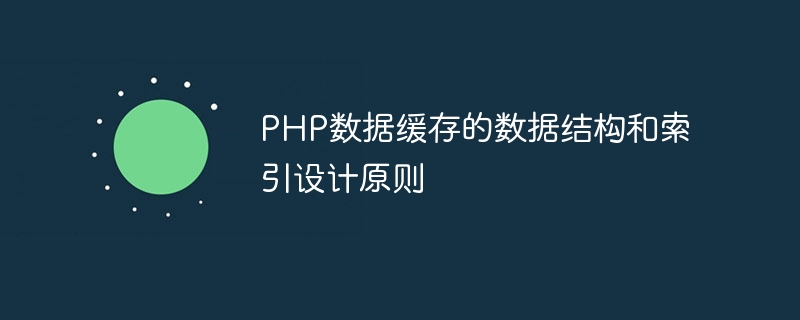

Data structure and index design principles of PHP data caching
In development, data caching is one of the important means to improve system performance and response speed. In PHP development, commonly used data caching methods include memory caching, file caching, database caching, etc. This article will discuss the data structure and index design principles of PHP data cache, and give corresponding code examples.
1. Data structure of data cache
Memory cache stores data in memory to improve access speed. Commonly used memory caching methods include Memcache and Redis. The following is a sample code for data caching using the PHP extension library Memcache:
$memcache = new Memcache;
$memcache->connect('127.0.0.1', 11211 ) or die ("Could not connect");
$key = "user_data_1";
$data = $memcache->get($key);
if($ data === false){
// 从数据库中获取数据 $data = getUserDataFromDB(1); // 将数据保存到内存中,并设置过期时间为1小时 $memcache->set($key, $data, 0, 3600);
}
//Use $data
...
File caching is a way of saving data in files. A common method of file caching is to save data as a file in JSON format. The following is a sample code for data caching using PHP's file reading and writing functions:
$cacheFile = "user_data_1.json";
if (file_exists($cacheFile ) && time() - filemtime($cacheFile) < 3600) {
// 从缓存文件读取数据 $data = json_decode(file_get_contents($cacheFile), true);
} else {
// 从数据库中获取数据 $data = getUserDataFromDB(1); // 将数据写入缓存文件 file_put_contents($cacheFile, json_encode($data));
}
// Use $data
.. .
Database caching is a way to save data in the database. Commonly used database caching methods are to use MySQL's Memory engine or Redis, etc. The following is a sample code for data caching using MySQL's Memory engine:
$pdo = new PDO('mysql:host=localhost;dbname=test;charset=utf8', ' username', 'password');
$pdo->setAttribute(PDO::ATTR_ERRMODE, PDO::ERRMODE_EXCEPTION);
$cacheTable = "user_data_cache";
$stmt = $pdo->prepare("SELECT * FROM $cacheTable WHERE id = ?");
$stmt->execute([1]);
$row = $stmt->fetch(PDO ::FETCH_ASSOC);
if($row){
$data = json_decode($row['data'], true);
}else{
// 从数据库中获取数据
$data = getUserDataFromDB(1);
// 将数据写入缓存表
$stmt = $pdo->prepare("INSERT INTO $cacheTable(id, data) VALUES(?, ?)");
$stmt->execute([1, json_encode($data)]);}
// Use $data
. ..
2. Index design principles for data caching
When caching data, a good index design can improve the reading efficiency of the cache. The following are some principles for data cache index design:
Ensure that cached keys are unique and avoid cached data conflicts. For example, when using Memcache for data caching, you can use the user ID as the key name.
Set an appropriate cache expiration time to avoid data reading errors caused by cache expiration. For example, when using file caching, you can set a file's modification time and check it periodically.
For frequently accessed data, you can consider loading it into the cache in advance to improve response speed. For example, when using database caching, hotspot data can be written directly to the cache table.
Update cached data in a timely manner to maintain the consistency of data in the cache and database. For example, when using database caching, you can use triggers or stored procedures to automatically update cached tables.
For multi-level data cache, nested cache keys can be used for indexing. For example, a cache of user data can be nested indexed by user ID and data type.
Summary
Through reasonable data structure and index design, we can make better use of PHP's data cache and improve system performance and response speed. In actual development, good results will be achieved by selecting an appropriate caching method based on specific needs and optimizing based on index design principles.
References:
The above is the detailed content of Data structure and index design principles for PHP data caching. For more information, please follow other related articles on the PHP Chinese website!




